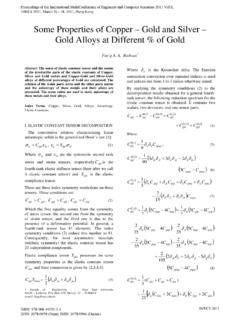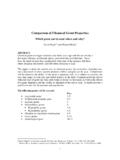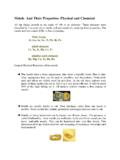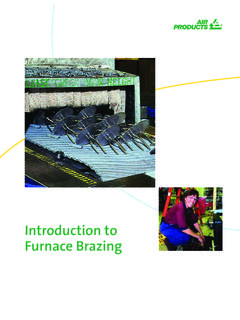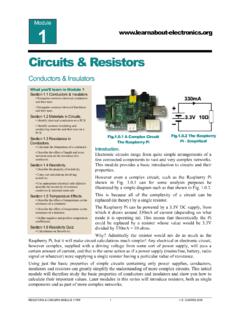Transcription of METAL PROPERTIES, CHARACTERISTICS, USES, AND …
1 SUBCOURSE EDITION. OD1643 7. METAL properties , characteristics , USES, AND CODES. US ARMY REPAIR SHOP TECHNICIAN WARRANT. OFFICER ADVANCED CORRESPONDENCE COURSE. MOS/SKILL LEVEL: 441A. METAL properties , characteristics , USES, AND CODES. SUBCOURSE NO. OD1643. US Army Correspondence Course Program 6 Credit Hours GENERAL. The purpose of this subcourse is to introduce the student to the properties of metals, their characteristics , uses and identification codes. The subcourse provides descriptions of the processes for identifying the physical and mechanical properties , categories of various metals, and the processes for using the hardness tester, chemical analysis, bench grinder, simple shop tests, the numerical index system, and the color code for identifying various metals.
2 Six credit hours are awarded for successful completion of this subcourse. Lesson 1: THE PHYSICAL AND MECHANICAL properties OF VARIOUS METALS, AND USE OF THE HARDNESS TESTER, CHEMICAL ANALYSIS, AND. BENCH GRINDER TO IDENTIFY VARIOUS METALS. TASK 1: Describe the processes for identifying the physical and mechanical properties of various metals. TASK 2: Describe the processes for using the hardness tester, chemical analysis, and bench grinder to identify various metals. i METAL properties , CHAR, USES, AND CODES - OD1643. TABLE OF CONTENTS. Section Page i TABLE OF ii Lesson 1: THE PHYSICAL AND MECHANICAL. properties OF VARIOUS METALS, AND. USE OF THE HARDNESS TESTER, CHEMICAL ANALYSIS, AND BENCH. GRINDER TO IDENTIFY VARIOUS. 1. Task 1: Describe the processes for identifying the physical and mechanical properties of various 1.
3 Task 2: Describe the processes for using the hardness tester, chemical analysis, and bench grinder to identify various 24. Practical Exercise 44. Answers to Practical Exercise 46. 48. ii METAL properties , CHAR, USES, AND CODES - OD1643 - LESSON 1/TASK 1. LESSON 1. THE PHYSICAL AND MECHANICAL. properties OF VARIOUS METALS, AND USE OF. THE HARDNESS TESTER, CHEMICAL ANALYSIS, AND. BENCH GRINDER TO IDENTIFY VARIOUS METALS. TASK 1. Describe the processes for identifying the physical and mechanical properties of various metals. CONDITIONS. Within a self study environment and given the subcourse text, without assistance. STANDARDS. Within three hours REFERENCES. No supplementary references are needed for this task. 1. Introduction Most of the metals and alloys used in Army materiel can be either welded or machined.
4 Repair part components, such as gears, shafts, and wheel vehicle body and tank hull components, can be repaired or fabricated. Repair or fabrication involves the employment of the various welding or machining processes available to intermediate direct support (IDS) and intermediate general support (IGS). maintenance units in the field. Hardware items such as nuts, bolts, screws, pins, and fuel line fittings can be machine fabricated, however, repair parts such as these are not always readily available in a combat situation. Further, such items as jigs and devices used in the repair of materiel are not stocked in the supply system. To compensate for these situations, IDS and IGS maintenance units in the field carry a supply stock of various metals from which to fabricate and/or 1.
5 METAL properties , CHAR, USES, AND CODES - OD1643 - LESSON 1/TASK 1. repair hardware, repair parts, jigs, and devices. But determining the type of welding or machining process needed to repair or fabricate these METAL component parts, jigs, and devices requires knowledge of the properties , characteristics , uses and identification codes of metals. The responsibility of ensuring that the personnel are trained, and of providing them with the capability to identify the various metals belongs to the shop technician in charge of the service section. For this purpose, the following paragraphs describe the processes for identifying the physical and mechanical properties of various metals. 2. Identification of Physical and Mechanical properties of Various Metals a.
6 General. The distinguishing characteristics or qualities that are used to describe a substance such as METAL are known as its physical properties . Those physical properties which describe the behavior of a METAL when it is subjected to particular types of mechanical usage are called mechanical properties . Subsequent paragraphs describe the physical and mechanical properties of metals. The mechanical properties are of chief concern and will therefore receive greater coverage. b. Definition of METAL and Alloy. (1) Before going into a discussion of the properties of metals, first let us define the terms " METAL " and "alloy". The basic chemical elements are divided into metals and nonmetals; however, there is no sharp dividing line between the two.
7 A METAL may be defined as a chemical element that possesses metallic luster and which, in electrolysis, carries a positive charge that is liberated at the cathode. Most nonmetallic elements do not possess metallic luster, and in electrolysis the nonmetals carry negative charges that are liberated at the anode. Of all the natural chemical elements, about 70 are metals and, of these, about 39 are used commercially. (2) An alloy is a metallic substance, but it is not a single chemical element. An alloy is formed by the union or mixture of two or more metals; in 2. METAL properties , CHAR, USES, AND CODES - OD1643 - LESSON 1/TASK 1. some cases, it may consist of one or more metals and a nonmetal. Examples of alloys are iron and carbon, forming steel, and the great variety of copper alloys, such as brass and bronze.
8 C. Physical properties . These properties are related to the atomic structure and density of the material, as described in the following paragraphs. (1) Co efficient of Linear Expansion. The co efficient of linear expansion is the increase in length of a body for a given rise in temperature. The increase is the changed length of a rod for each degree that the temperature is increased. METAL expands when heated and contracts when cooled. It increases not only in length, but also in breath and thickness. The increase in unit length when a solid is heated one degree is called the co efficient of linear expansion. (2) Heat and Electrical Conductivity. Heat and electrical conductivity is the ability of a material to conduct or transfer heat or electricity.
9 (3) Magnetic Susceptibility. Magnetic susceptibility is the ability of a material to hold a magnetic field when it is magnetized. (4) Reflectivity. Reflectivity is the ability of a material to reflect light or heat. (5) Specific Gravity. Specific gravity is the ratio of weights between two objects of equal volume, one of which is water. (6) Melting Point. The melting point is the temperature at which a substance passes from a solid state to a liquid state. d. Mechanical properties . (1) Strength. The strength of a material is the property of resistance to external loads or stresses while not causing structural damage. Ultimate strength is the unit stress, measured in pounds per square inch, developed in the material by the maximum slowly applied load that the material can resist without rupturing in a tensile test.
10 The strength of metals and alloys depends upon two factors: the strength of the crystals of which the metals are constructed, and the tenacity of adherence between these crystals. The strongest 3. METAL properties , CHAR, USES, AND CODES - OD1643 - LESSON 1/TASK 1. substance known is tungsten molybdenum; titanium and nickel follow in order of strength of commercially pure metals. Pure iron is much weaker, but, when alloyed with the chemical element known as carbon". to make steel, it may then become stronger than any of the pure metals except tungsten. Strength and plasticity (discussed in paragraph 2d(6) on page 6) are considered the two most important properties that a METAL can possess. (a) Tensile Strength. Tensile strength is the ability of a METAL to resist being pulled apart by opposing forces acting in a straight line (figure 1, view A, on the following page).

